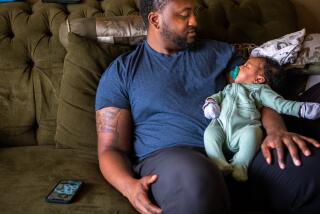Dad’s role in breast cancer
- Share via
Genetic links to breast and ovarian cancers may be hidden in some families in which there are few aunts and other female relatives, doctors have reported.
Because some families are so small and with so few female relatives, doctors and patients themselves sometimes suspect their breast or ovarian cancers are sporadic, occurring with no apparent familial link. Risk, doctors have now learned, sometimes is hidden on the paternal side.
Either of two genes known as BRCA 1 and BRCA 2 can lead to breast cancer when they are mutated, and they can be transmitted from grandfather to father to daughter just as readily as they can flow from grandmother to mother to daughter, researchers say.
“A lot of people -- doctors included -- forget that Dad can be the contributor.
And a patient can be blinded as to what’s happening on the paternal side,” said Dr. Jeffrey Weitzel, a professor of oncology and population science at City of Hope Cancer Center in Duarte. Weitzel’s analysis was published in the June 20 issue of the Journal of the American Medical Assn.
What if a man has no sisters and his daughter develops breast cancer, Weitzel asked. Then, not only is the cancer risk hidden, but the patient also misses a key opportunity for genetic screening that could reveal more about her risk and implications for future generations.
“BRCA genes are not new in families,” Weitzel said. “They are all quite ancient.”
Weitzel is calling for a change in current insurance guidelines, which dictate reimbursement for genetic screening based on obvious patterns of inheritance. That test can cost up to $3,000.
Dads, they say, are as important as moms in determining risk.
Dr. Noah D. Kauff, a physician in clinical genetics and gynecologic services at Memorial Sloan-Kettering Cancer Center in Manhattan, said the study called into question several major assessment models used to determine who receives cancer screening, based on risk.
Recently, the American Cancer Society, Kauff said, suggested women who run a 20% to 25% risk of breast cancer be offered MRI screening, a measure that would help catch a tumor in an early, treatable stage.
Weitzel added that a family structure with few women might seem to have been a notion that statisticians would have considered when designing risk models, but no one until now had thought of it. “Family structure is very, very important when considering risk,” Weitzel said.
He studied genetic test results of 306 women diagnosed with breast cancer before age 50. Breast or ovarian cancer before age 50 usually is a sign of a genetic link.




